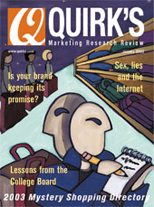Editor’s note: Robert J. Morais is chief strategic officer at Carrafiello Diehl & Associates, an Irvington, N.Y., advertising agency.
In a recent focus group on toilet bowl cleaners, my colleagues and I were stupefied when user after user left one of the primary benefits of their regular brand off of their list of most important brand attributes. This benefit, “leaves the bathroom fresh,” has been a centerpiece of communication, supported by millions of media dollars, for every toilet bowl cleaner brand these users bought. They certainly talked about how clean their toilets were, so why did they not mention the benefit that we - and our competition - felt was so important?
It struck me that those of us in the back room, along with the moderator, were being too literal in our interpretation of what we heard. In fact, we were not interpreting at all. We were taking the respondents’ words at face value - the denotation - and missing the hidden meaning of their words - the connotation. We needed to explore the possibility that “clean” not only meant free of dirt but also fresh smelling. The benefit of “leaves the bathroom fresh” may have been expressed indirectly by respondents with a single word that held several meanings for them but only one for us marketing professionals.
Denotation is the literal meaning of a word; connotation is a word’s broader, symbolic, often more suggestive, meaning. The word “Thanksgiving” denotes a holiday on the calendar; its connotations are vast: a gathering of family and friends; a day to appreciate all that we have; permission to overindulge in food; a time to reflect on our national history; long, traffic-clogged trips on the highway; college football games, etc. The same can be said for virtually any word, or any benefit, uttered in a focus group. When we take a word at its literal meaning, we can miss critical information. We can make mistakes. On the other hand, sometimes we can learn a thing or two.
A number of years ago, I was involved in observational research for a well-known floor cleaner. We pre-recruited women who were willing to have marketing and advertising types in their homes watch them use our product in their natural habitat. So far, so good. The problem arose when our respondents removed a generic version of our brand from their cupboard and referred to it without hesitation or apology as our brand. Even after questioning, with the generic right before their eyes, respondents used our brand name! We realized that, despite all our advertising, we had not done a sufficient a job of separating ourselves from competing knockoffs. Consumers were connoting brand meaning from a generic look- and sound-alike. Our recruiting mistake - assuming that when they said they used our brand they meant our brand - actually led to valuable learning.
We all know that words can have multiple meanings, a function of the user’s personal definition and/or the context in which a word is used. But the design and pace of many focus groups precludes the kind of probing that will reveal what respondents are really saying. A question is asked, answered by respondents, followed up with a related question, and so on. And, yet, in light of the example that began this essay, we cannot afford to skim the surface of respondent commentary. We should stop and examine key words and phrases. We should conduct “semantic chains” in which we work with respondents to list synonyms, building an on-the-spot thesaurus that will open up new conceptual venues, stimulate discussion and generate insight.
Qualitative research on a brand is much like the connotation of a word. It adds texture and meaning that eludes more denotative quantitative research methods. The deeper we probe connotation, the more certain we can be that we understand what our respondents are really saying.
